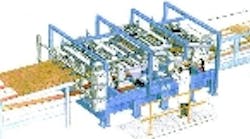Manufacturing of oriented strand board requires a combination of high pressure and elevated temperatures — a combination that holds a high potential for fire unless fireresistant hydraulic fluids are used.
By Alan L. Hitchcox
Oriented strand board (OSB), sometimes called fiber board, is being used more and more in construction projects because its cost-to-strength ratio is lower than that of plywood and natural wood. OSB manufacturing requires multiple processing steps, many of which involve hydraulics.
First, logs are debarked, cut, and shredded into flakes. The flakes then are heated to remove moisture and conveyed to the next operation or to storage silos. The next operation blends the flakes with resins, and the composite mixture undergoes heating, pressing, forming, and curing operations. Finishedsheets are then cut to nominal-dimensions and conveyed to an area where they await shipping.
Safety first
Because manufacturing of OSB requires pressurized hydraulic fluid in close proximity to heat sources, the potential for fire exists should leakage occur — almost always caused by a lack of proper maintenance. Potentially, though, even if good maintenance is practiced, a catastrophic failure could cause a fire. Therefore, using a fire-resistant hydraulic fluid generally is the most practical way of eliminating — or at least dramatically reducing — the potential for fire.
"Petroleum-based hydraulic fluids and extreme applications like OSB pressing do not mix," explained Tony Noblit, product manager, Fluid Power Div., Houghton International, Valley forge, Pa. "Hydraulic fluid may leak from the hydraulic presses that compress wood strands into OSB to pose an explosion risk because these presses create extreme heat and pressure. Houghton fire-resistant fluids eliminate this risk, protecting employees and property."
Noblit said Houghton is the only supplier of all types of water and anhydrous fire-resistant hydraulic fluids, including water glycols, high water content fluids, invert emulsions, polyol esters, phosphate esters,and vegetable oil-based fluids. He added Houghton's line of fireresistant hydraulic fluids provides superior performance and greater safety than petroleum-based fluids in high-pressure applications like OSB manufacturing.
Noblit pointed out that Houghton also has a line of fluids derived from a natural ester that are biodegradable and add virtually zero toxicity to the environment.
For more information, visit www.houghtonintl.com or call (610) 666-4000.


